Royal Enfield has launched a number of very successful models over the last few years, and it seems to be showing no signs of slowing down, even with the entry-level models to its range.

Words: Dave Manning Photography: Gary Chapman
It probably comes as something of a surprise to many people – given that the Bullet has been the backbone of Enfield’s production for, essentially, the greater part of the company’s existence (especially so with regard to machines built since the move to production in India) – but the new 350cc Bullet isn’t a new machine in entirety. It’s based on the Meteor, that was launched into the UK market back in 2021 with the new air-/oil-cooled overhead cam J-series engine. The Meteor itself replaced the Meteor version of the previous pushrod-engined Bullet, which was incredibly popular in the Indian home market, and that was probably the root reason behind the new Meteor being launched ahead of the new Bullet, rather than the other way around.
Enjoy everything MSL by reading the monthly magazine, Subscribe here.
While not chasing outright power with the J-series, Royal Enfield has developed an engine that is incredibly flexible in its delivery. Impressively for an engine of this capacity, top gear (only five speeds in this ’box) is capable of pulling from as low as 30mph, with no complaints (albeit not at a particularly rapid rate of knots), thus making for a very relaxing ride on twisting country lanes or, for that matter, in busy urban traffic. Although it’s in the former rural environment that the bike excels, exploring tight and twisting byways, luxuriating in the slow speed manoeuvrability, leisurely power delivery and relaxing soundtrack.
For that ‘Dof-dof-dof’ of the engine ticking over really is ‘the sound of India’. While on a tour of the Himalaya, nigh on a decade ago, I was introduced to the fact that Indians hold the Bullet very dear, with the exhaust note defining the soundtrack to both the Indian countryside and also towns and cities, too. The new Bullet hasn’t lost any of that cache – not only does it look right, it also sounds right. To the point that, when photographer Gary Chapman joined me on an icy Lincolnshire lane for the pics, with the Bullet minding its own business, parked on its centrestand and ticking over in the background, Gary commented: “That sounds nice, really relaxing ain’t it?” A comment that brought to mind the young Indian gent who mentioned to me that he often sits and reads a book while his Bullet ticks away next to him, like a two-wheeled metronome…
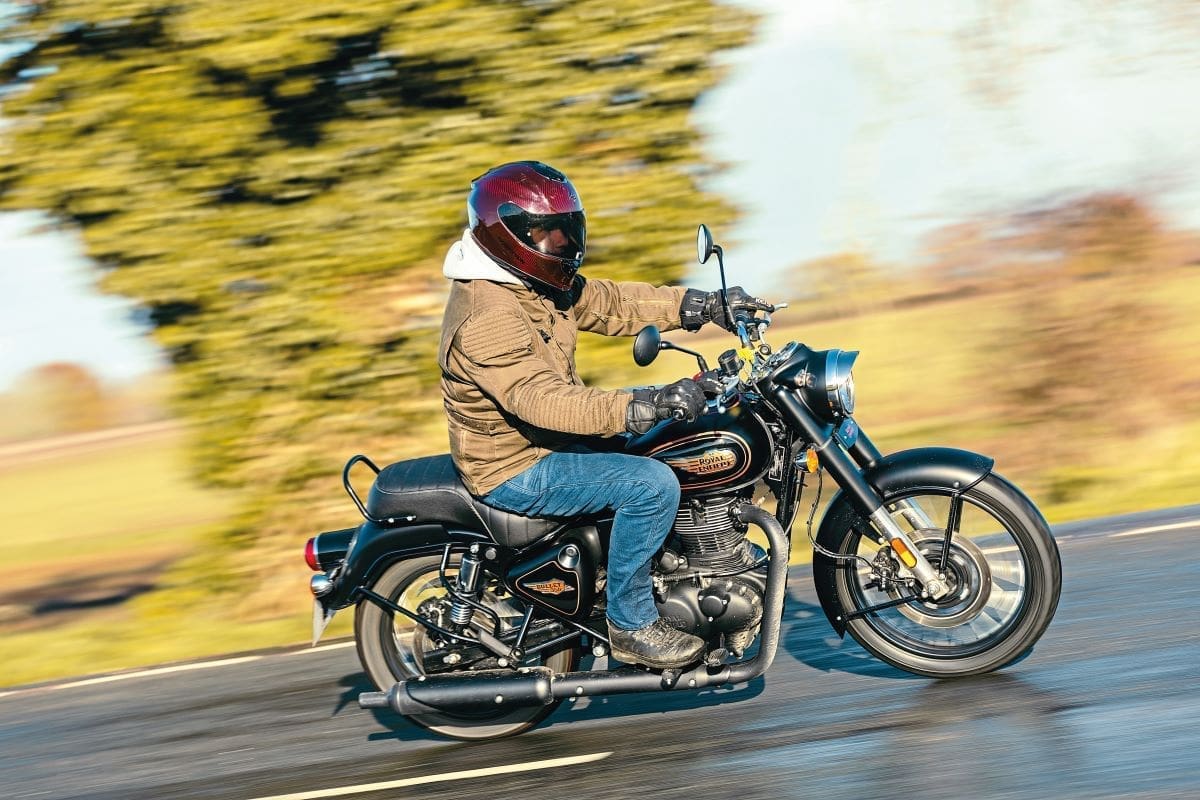
But eulogising the acoustic properties of a 349cc four-stroke single doesn’t inform you of the bike’s riding properties, so it’s time to sling a leg over the 805mm high seat and get the wheels rolling. While it was a fresh and frosty morning, the sun was trying to burn through the mist, albeit with little hope of drying the Tarmac. The Ceat tyres were a little sketchy on the cold and wet roads, albeit not quite as bad as I thought they might be, and if the roads were warm and dry I would’ve had no issues whatsoever, but did feel that, if it were mine and I were riding through the winter, I could easily be persuaded to fit some potentially grippier tyres.
The riding position seems, initially, to be a little cramped thanks to the bike’s dimensions being smaller than so many other bikes. But the relationship between the seat, pegs and bars actually works very well, and really helps with the incredibly tight turning circle that the Bullet enjoys, given that there is never a stretch to the bars, even when on full lock. That, and the light clutch action, meant that turning around in the road, feet up, for another pass in front of the camera was a cinch, a good indicator as to how competent the bike would be in the urban chaos of the commuter run.
The suspension may be basic, and follows form with regards to what the bike’s style and spec reflects in that there is only adjustability in the form of preload on the rear shocks, but it copes with the vagaries of British Tarmac admirably and it’s clear that the knowledge brought to the Indian firm when they invested in Hertfordshire chassis experts Harris Performance has ensured that all of the recent Royal Enfield models have exhibited beautifully neutral yet responsive handling and steering.
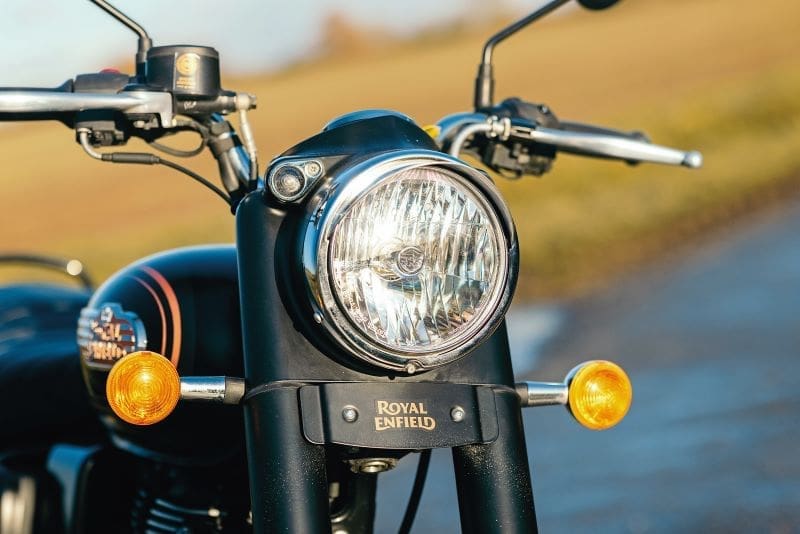
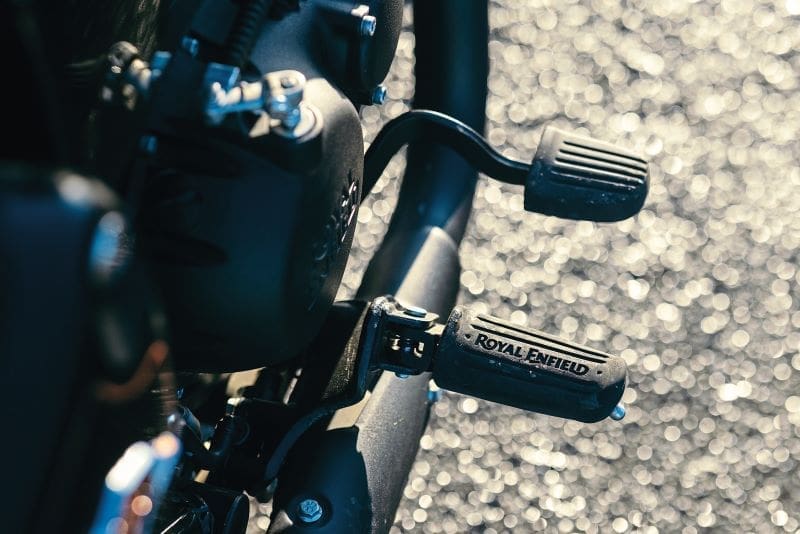
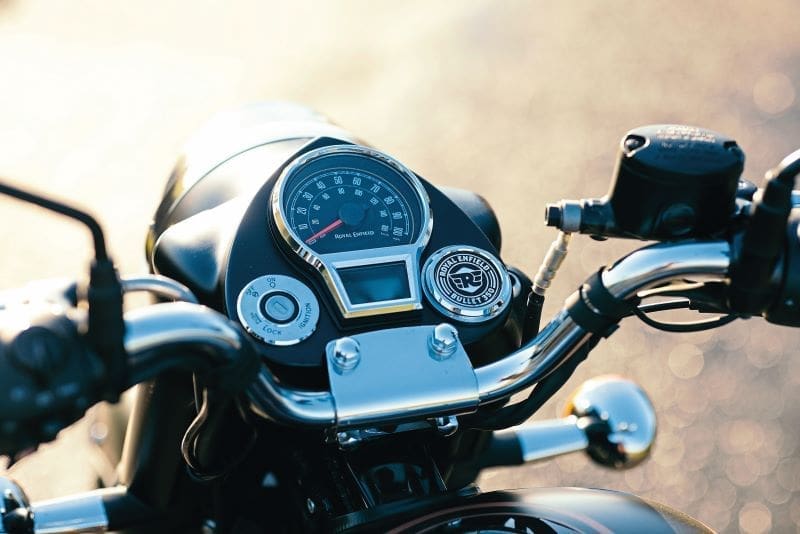
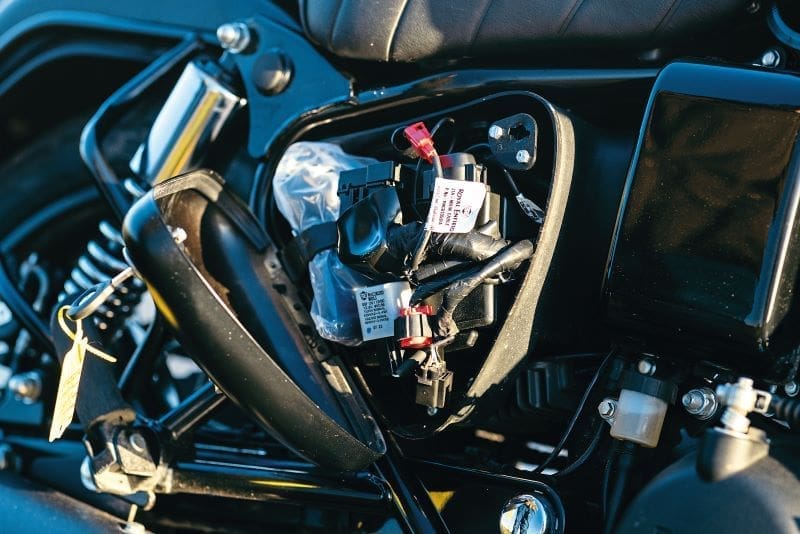
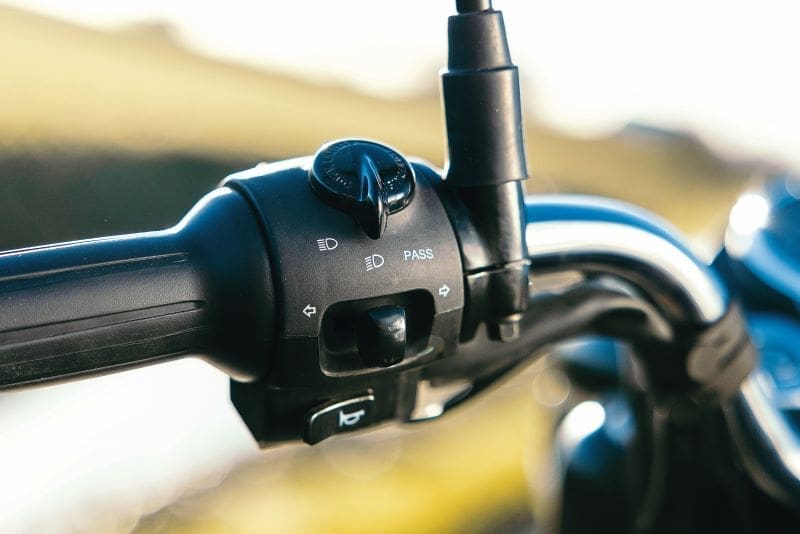
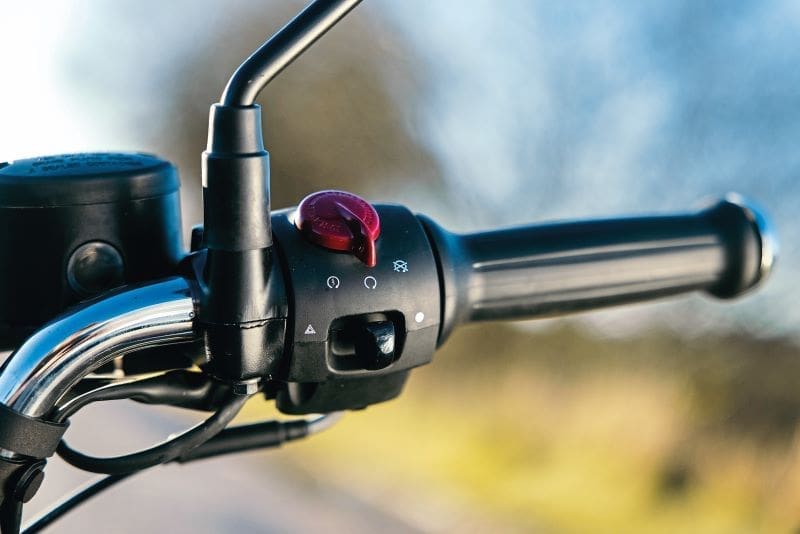
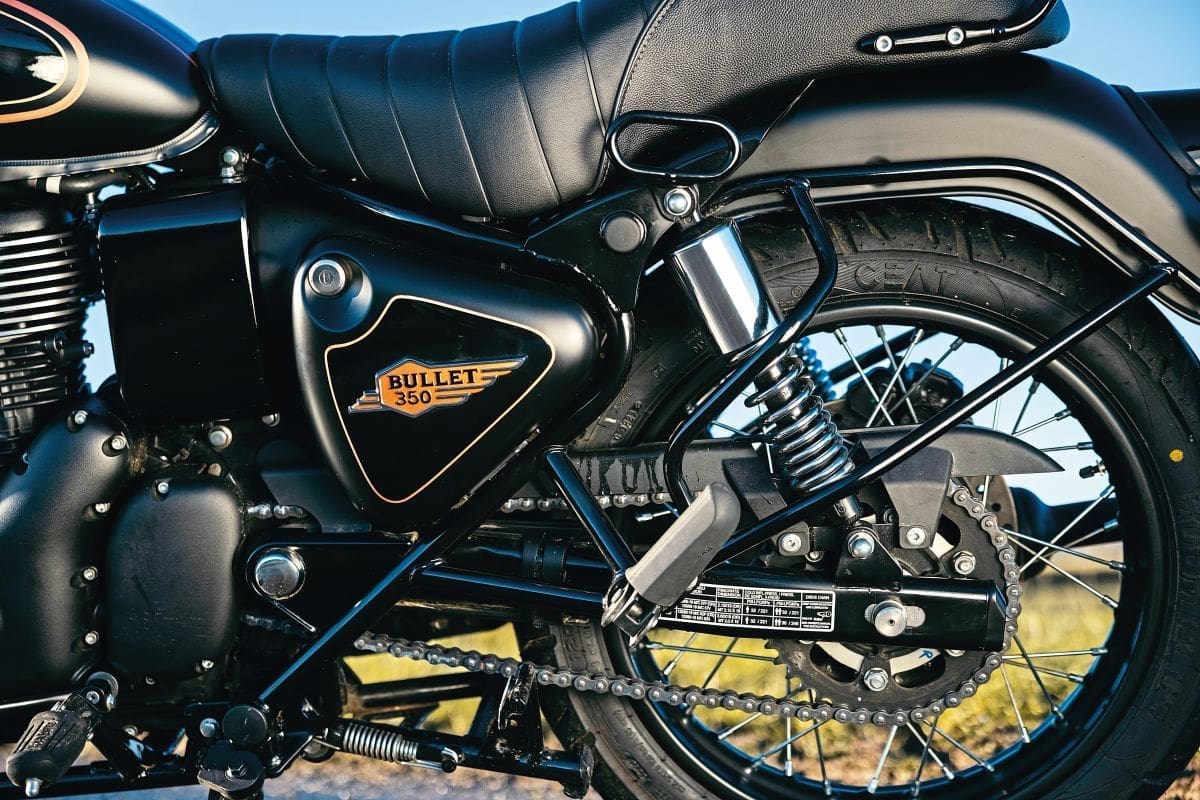
The rear brake is very effective, and not so harsh as to cause incident, and the front is also rather more impressive than I’d expected given it’s somewhat dated nature and, while the brakes aren’t the stop-on-a-sixpence, rubber-howling stoppers that’ll have the rear wheel waving in the air and rubber smeared across the road, they are significantly better than the old bikes that the most recent iteration of the Bullet so faithfully replicates. After all, there’s absolutely no requirement for four-piston, radially-mounted calipers biting on a pair of 320mm diameter discs when you’re only hauling 195kg to a halt from no more than 70mph. When used together, the new Bullet stops far quicker than any classic bike.
Given that the national speed limit is, pretty much, all you’ll be getting from the 20-horsepower engine, one does wonder about longer trips on the Enfield – will it cope? Bearing in mind that it does buzz along quite happily at the national limit (well, it did on the longer stretches of single carriageway I rode on – there’s not a lot of dual carriageway in Lincolnshire, and no motorways), I’d say that longer journeys will bring no issues, with a side statement being that it might feel a little overwhelmed if you’re riding the length of the M1, or encountering the faster stretches of the M69 or M40 that seem to attract a higher average than the legal limit. Any thoughts of trying out German Autobahns should be dismissed swiftly. But then, if you’re thinking of covering large distances in minimal time, the chances are that you’d not be looking at the Enfield anyway.
But, that said, don’t dismiss it entirely from touring. If you look towards exploring lesser-populated routes, smaller A roads, B roads and unclassified byways, then might I suggest that the Bullet is close to being ideal. All-day-long comfort and brilliant fuel consumption mean that you can just keep covering the miles, whilst not getting caught up in the rush to arrive at your destination – surely the most relaxing way to travel? After all, the phrase, ‘It’s not about the destination, it’s all about the journey’ was surely invented for motorcycle use? The factory claims that the little single will sip fuel at a rate of 107mpg and, while I didn’t actually record the consumption when the Enfield was in my care, I’d guess at it being a little less frugal. But with almost three gallons in the tank, you’ll certainly be able to cover well over 200 miles without even thinking about a petrol station.
And joy of joys – there are no rider modes! Nothing to fettle with, nothing to change, nothing to confuse. Just plain and simple motorcycling. The easy-to-read dash has the big speedo, and a digital trip (odometer and two trips), with the clock and fuel gauge. Consequently, with little in the way of buttons and dials, the switchgear is really easy to use, on both sides. The horn button doesn’t interfere with the indicator switch (can you hear me Honda?), and the trip button is easy to operate, too. There’s a lot to be said for keeping things simple, and it’s not just ensuring that there is less to go wrong. With less electronics, fewer accessories, and not as much to distract you from the actual riding itself, the Bullet brings a certain level of purity, of focus, of being very much ‘in the moment’. Recent times have brought a greater awareness of mental health, and the importance of ‘mindfulness’. And I found that with the Bullet.
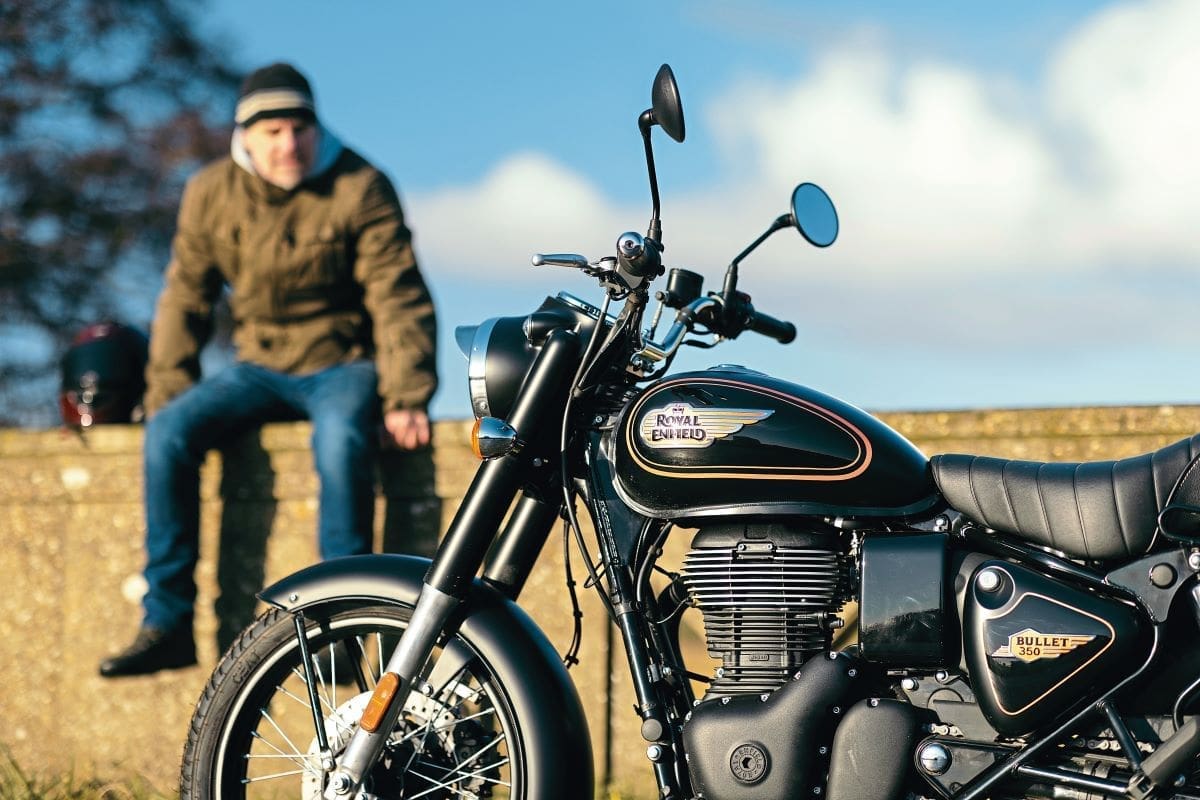
And there’s also a point that really impressed me and is something that just about every other manufacturer on the planet could do with making note of. The Bullet is incredibly practical. Not just in terms of its initial cost and the efficient use of fuel, but day-to-day practical in the way that so few bikes are. It has a centrestand, and one that is really easy to use, thanks in part to the grab handle on the left-hand side. So easy to use, in fact, that the bike doesn’t really need the sidestand (which, also, is really easy to use). The front mudguard, which really suits the style, has the convenient side effect of being brilliant at reducing the level of spray, mud and detritus that gets flung on to the front of so many engines. Compare this to, say, the front muddie on a Ducati Scrambler… The aforementioned steering lock is superb, not just perfect for feet-up u-turns in narrow roads, but also threading through traffic and manoeuvring in parking spaces and garages. The electrics box, behind the side panel on the right-hand side, is not only easy to access, but also contains an impressively varied tool kit. Yes, a complete toolkit that includes more than just a pair of Allen keys (please take note, Yamaha and Ducati). The pillion seat grab rail and the bars that run from the rear mudguard and wrap around the rear shocks are not only great for keeping fabric panniers in place and away from the back wheel, but also ideal for retaining bungee cords. The mirrors aren’t the best around, but nor are they the worst – they do what is required.
The classic, yet understated, good looks are only, in my mind, spoilt by the headlight peak, although I do understand that some folk will like the look. I prefer a naked headlight rim, although the headlight/fork shroud is a lovely shape that incorporates the ‘bullseye’ running lights as well as being neatly shaped around the speedo bezel, and the shrouds that extend down to cover the top of the fork sliders will probably mean that the fork seals will never, ever, need to be changed. There are some modernities applied though, with a USB port on the bars if you want to have a charging lead to phone/satnav, and, of course, it does have the compulsory anti-lock braking system required now.
In fact, as beguiled as I was by the Bullet, I would say that it is only the other J-series bikes in the company’s range that can detract from its desirability. While the Hunter, Meteor 350 and Classic don’t have the same comfortable ergonomics as the Bullet, each of them is cheaper (about £700, £600 and a tenner respectively, the Black Gold version of the Bullet you see here is £80 more than the plain black or maroon versions). And the sales success of the company’s parallel twins means that folk are getting used to seeing Enfields regularly, the end result of which is that they are no longer viewed as being a hangover from the British bike industry. The Bullet is no longer just a second bike for someone who wants an easy classic, or a cheap bike to use as a commuter while the favourite machine is kept for Sunday best. The Bullet is now a refreshing antidote to 21st Century life. A way of escaping the nine to five, and of bringing a smile to cynical lips. And isn’t that exactly what motorcycling is all about?
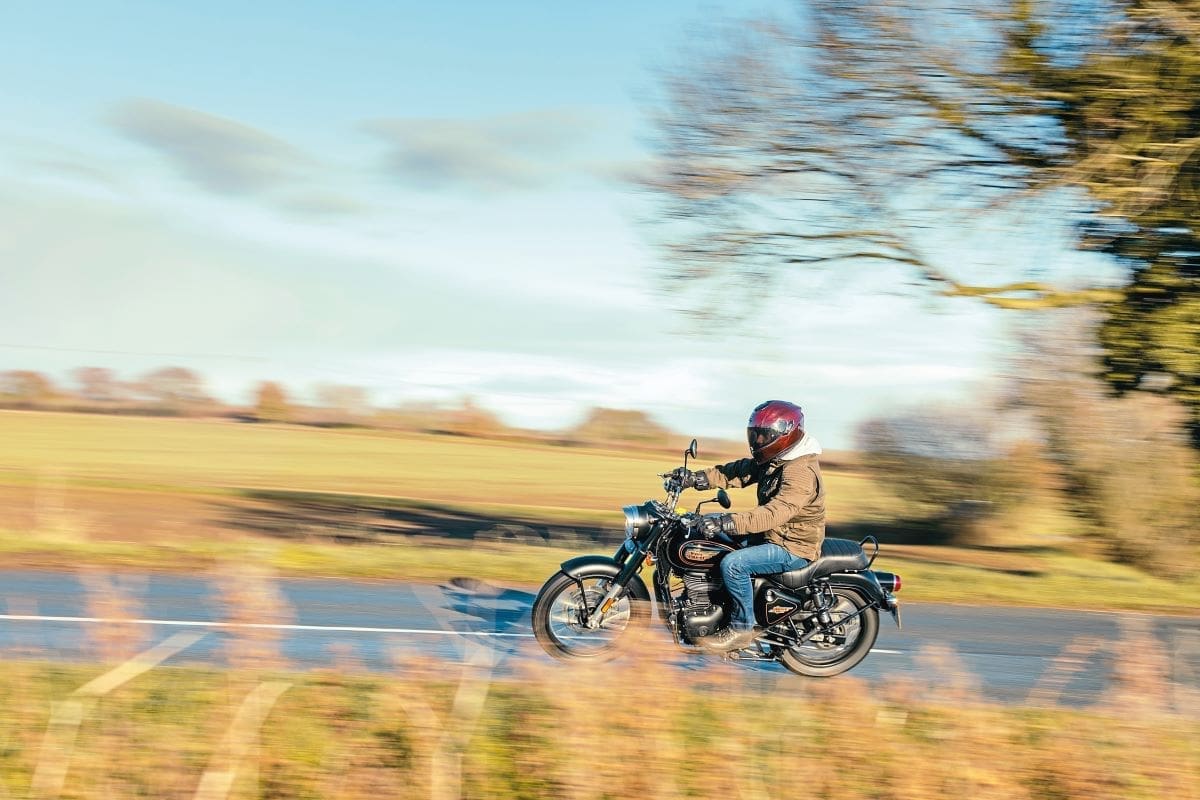
Specification
Royal Enfield 350 Bullet Black Gold
Price: £4709
Engine: 349cc, single cylinder, single overhead cam, oil-/air-cooling, 2v
Power: 20.2bhp (14.9kW) @ 6100rpm
Torque: 20lb-ft (27Nm) @ 4000rpm
Frame: Steel twin downtube spine frame
Wheelbase: 1390mm
Brakes: (F) 300mm disc, twin piston floating caliper, (R) 270mm disc, single piston floating caliper
Transmission: 5 gears, chain final drive
Suspension: (F) 41mm telescopic forks, 130mm travel, non-adjustable, (R) dual twin tube emulsion shock absorbers, 6-step preload adjustment
Wheels/Tyres: (F) spoked wheel, 100/90×19” Ceat Zoon Plus tyre, (R) spoked wheel, 120/80×18” Ceat Zoon Plus tyre
Seat height: 805mm
Fuel capacity: 13 litres
MPG: 107mpg (claimed)
Weight: 195kg
Warranty: Two years
Service intervals: 6000 miles
Contact: www.royalenfield.com






